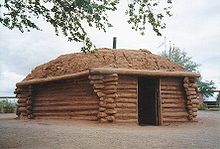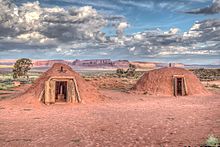

This article needs additional citations for verification. Please help improve this articlebyadding citations to reliable sources. Unsourced material may be challenged and removed.
Find sources: "Hogan" – news · newspapers · books · scholar · JSTOR (October 2018) (Learn how and when to remove this message) |

Ahogan (/ˈhoʊɡɑːn/or/ˈhoʊɡən/; from Navajo hooghan [hoːɣan]) is the primary, traditional dwelling of the Navajo people. Other traditional structures include the summer shelter, the underground home, and the sweat house. A hogan can be round, cone-shaped, multi-sided, or square; with or without internal posts; with walls and roof of timber, packed earth, and stone in varying amounts, and a bark roof for a summer house.[1] The door traditionally faced east to welcome the rising sun, believed to bring good fortune.
Today, while some older hogans are still used as dwellings and others are maintained for ceremonial purposes, new hogans are rarely intended as family dwellings.
Hogans are also considered pioneers of energy efficient homes. Using packed mud against the wooden walls, the home was kept cool in summer by natural ventilation and water sprinkled on the packed dirt floor. In winter the fireplace kept the inside warm well into the night, due to the high thermal mass of earth in the construction.[2]
This article possibly contains original research. Please improve itbyverifying the claims made and adding inline citations. Statements consisting only of original research should be removed. (July 2020) (Learn how and when to remove this message)
|
The preference of hogan construction and use is still very popular among the Navajos, although the use of it as a home shelter dwindled through the 1900s, due mainly to the requirement by many Navajos to acquire homes built through government and lender funding – which largely ignored the hogan-style and cultural needs of a community – in preference for HUD-standardized construction.[3]


With government and lender requirements requiring low costs, as well as bathrooms and kitchens, the hogan as a person's home was dwindling away, save for those who could build their own. That began to officially change in the late 1990s with various small projects to find ways to bring the hogan back.
In 2001, a joint venture involving the Navajo Nation, Northern Arizona University, and the US Forest Service began building log hogans with materials from a Navajo-owned log home factory in Cameron, Arizona, next to the Cameron Chapter House, using surplus wood culled from Northern Arizona forests to prevent wildfires. Through cooperation among elders, medicine men, and project leaders, this ancient Navajo tradition is reviving. While providing the traditional sacred space of the hogan, new construction also meets requirements for modern amenities. The project has also provided jobs, summer school construction experience for Navajo teens, and new public buildings.[4]
Possible Native American sources of the English word hogan:
|
| ||
|---|---|---|
| Traditional immobile |
| |
| Traditional mobile |
| |
| Open-air |
| |
| Modern |
| |
| Related topics |
| |
| ||
|
| |
|---|---|
| Native and indigenous |
|
| Colonial and post-colonial |
|
| Early Republic |
|
| Mid-19th century |
|
| Victorian |
|
| Late-19th to mid-20th century |
|
| Post–World War II |
|
| Building types and vernacular |
|
| Cities |
|
| States |
|